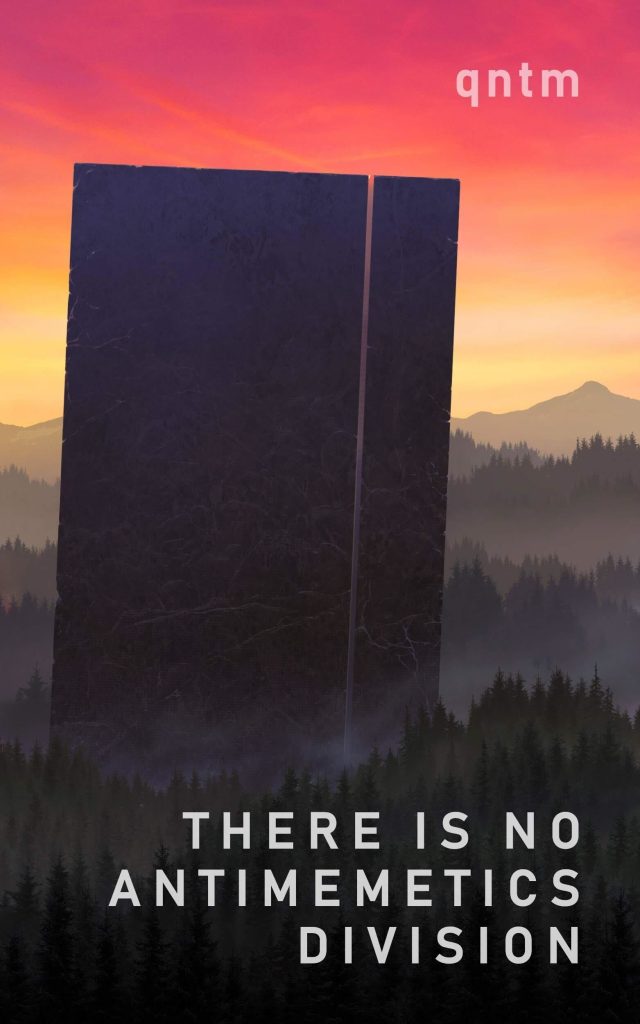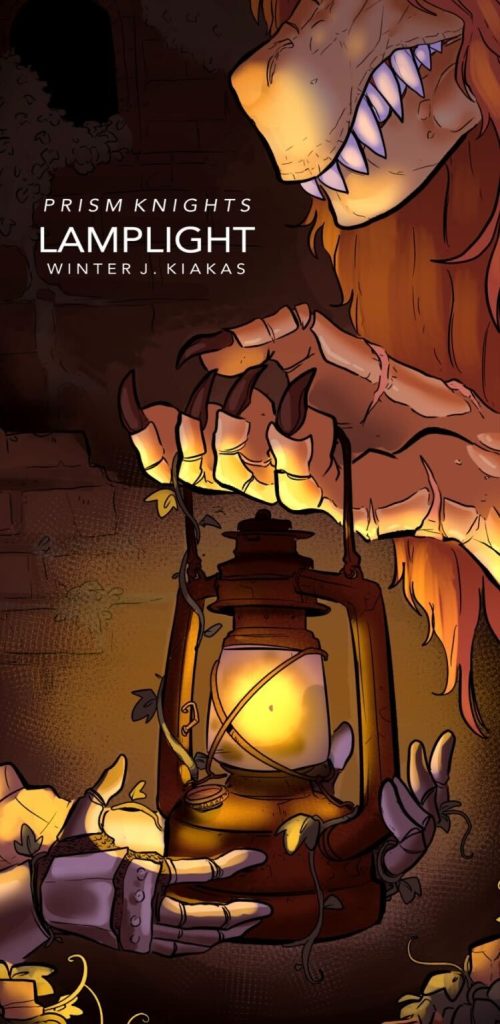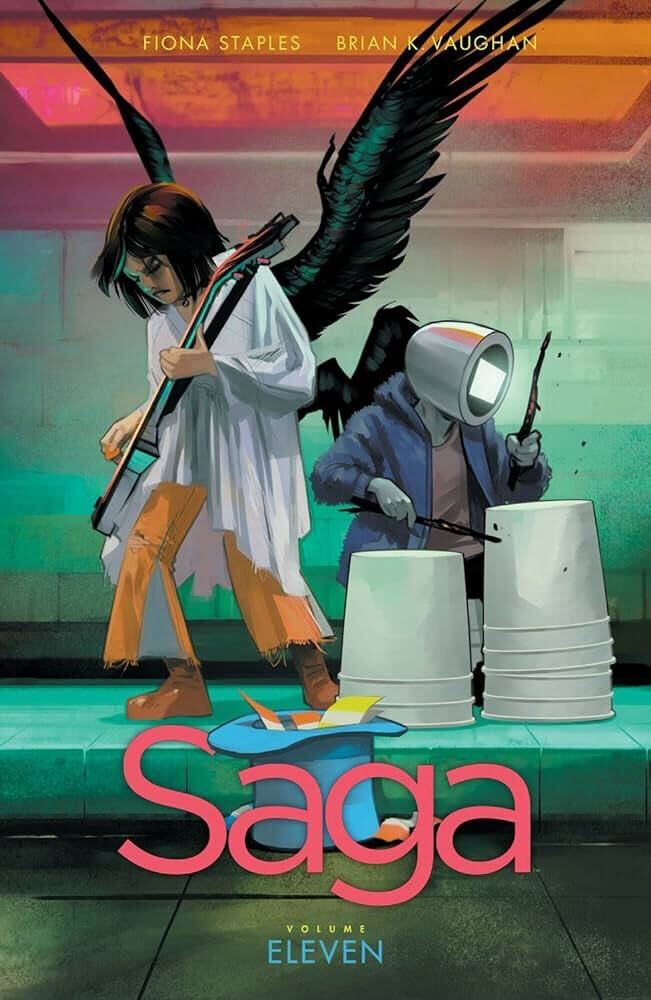There Is No Antimemetics Divisions
By Aya Amer

Sam Hughes, who writes under the name qntm, is a science fiction writer and occasional contributor to the SCP Foundation Wiki. There Is No Antimemetics Division is one such contribution, and it’s his best work to date. The short stories in this collection combine an original idea with the kind of high stakes that will have you reading through the night.
If a meme is an idea that spreads through self-replication, then an antimeme is the opposite—an idea that suppresses its own dissemination. This might happen because you’re disincentivized to share it (like a password), because it renders you incapable of transmitting the information to others (no one can hear from you if you’ve been eaten), or because you find it hard to even retain the idea (has that giant rock always been there?). Some antimemes are harmless, some are malevolent, and it’s the job of the Antimemetics Division of the SCP Foundation to deal with them all.
The first half of the short stories in this collection center a different antimemetic artifact each, while the threat of a more sinister force coalesces in the background. This format allows Hughes to take the singular idea of an antimeme and examine it from all angles: what would it be like to learn that these things exist—and then learn about them again, and again? How do you contain such a thing? And, if you can no longer contain it, how do you fight an enemy that suppresses knowledge of its own existence or uses your awareness of it as a weapon against you?Unlike Hughes’ previous works, There Is No Antimemetics Division features characters you can really root for, instead of paper dolls who exist only to be pushed around by the plot. Best of all, you can read it for free on the SCP Wiki website. Be warned, though: these stories are not for the faint-hearted. They start out playfully enough, but the final Lovecraftian monster might have you wishing the narrative itself was an antimeme.
Lamplight
By Magdalena Nitchi

Ce mois-ci, j’ai eu envie de revenir sur une série de nouvelles que j’avais commencée l’année dernière mais que je n’avais jamais terminé: Prism Knights, une série fantasy queer de Winter J. Kiakas. La sixième tome de Prism Knights, Lamplight, bien que n’étant pas une suite directe de Sapphire, est néanmoins plus amusant si vous l’avez d’abord lu.
Lamplight, une de ces nouvelles qui est vaguement basée sur La Belle et la Bête, suit Agatha Rowe, une femme transgenre et une ancienne chevalière maudite en voie de devenir un monstre. Kiakas emmène le lecteur à travers la transformation d’Agatha en bête, son isolement dans un château et sa rencontre avec la chevalière qui l’aide à retrouver son identité personnelle. Cette sauveuse s’avère être MidKnight Ivy, qui a recommencé à parcourir le pays après les événements de Sapphire. Ivy et Agatha se rapprochent en partageant leur passé de chevaliers et leurs luttes, et elles forgent une nouvelle relation. Mais cette relation résistera-t-elle à l’arrivée d’un duo de méchants chevaliers de leur passé ?
Même si toutes les nouvelles traitent des thèmes de la santé mentale et des traumatismes, Lamplight en est l’analogie la plus directe. La malédiction d’Agatha est liée à sa vision d’elle-même: plus ses ténèbres internes grandissent et plus elle se sent moins chevalière, plus elle devient monstrueuse. Son cycle de honte, d’automutilation et d’isolement est raconté avec empathie et compréhension.
L’une des choses que j’apprécie le plus dans Prism Knights est la représentation décontractée des personnages LGBTQ+. Le fait qu’Agatha est transgenre revient à plusieurs reprises lorsqu’on évoque son passé. Cependant, il n’y a jamais de remise en question sur son identité ou sur la manière dont elle a fait sa transition, permettant ainsi à tous lecteurs trans de s’imaginer à sa place.
Lamplight est une belle histoire sur la découverte du bien et de la lumière en soi-même, malgré les difficultés. Agatha est un personnage magnifique et réaliste, et j’espère la revoir en poursuivant la lecture de cette série. Tous les lecteurs intéressés en fantaisie queer devraient absolument lire cette collection. Chaque œuvre est courte mais bien rythmée, et j’ai hâte de voir comment les autres histoires se développeront.
Saga vol. 11
By Olivia Shan

Beware of minor spoilers (it’s 2024; go read Saga!)
It feels so good to finally be able to anticipate yearly volumes of Saga again. Diving into Volume 11 during a dry work shift felt like something of a New Year’s gift for myself, and it left me entertained, comforted, and feeling faintly nostalgic.
For the uninitiated, Saga is a space opera epic sci-fi/fantasy comic that has been running for the past eleven years. The series features many genre staples: forbidden love, sex, gory violence, a huge cast of eclectic characters, and an intergalactic war as its backdrop. Veteran comic book writer Brian K. Vaughan grounds his fast-paced story with humour and gut-punching emotion, while Fiona Staples’ sumptuous art continues to awe readers, new and old. With millions of copies sold and countless prizes and translations, I dare say Saga might be the single most iconic comic series of the past decade.
Ever since the legendary comics duo returned from their 4-year hiatus, they’ve been steadily churning out new issues featuring our usual protagonists who’ve similarly experienced a time jump of their own. Hazel, daughter of Saga’s pivotal star-crossed lovers Marko and Alanna, now firmly stands as the series’ lead protagonist, alongside her sidekick adopted brother Squire, the orphaned heir to the Robot Kingdom.
In the three years following the devastating events that shattered their families, Alanna has been preoccupied with finding financial opportunities to provide for her children. These chapters see our protagonists at their most scrappy, as they sleep in temporary tents and hop through a series of soul-sucking jobs. Meanwhile, on the planet Landfall, Secret Agent Gale is reassigned his old mission to eliminate the “traitor” Alanna and starts hunting down every possible lead.
Volume 11 is a more transitional volume, jumping through subplots and offering tantalizing glimpses at some old fan-favourite characters, but Vaughan is clearly building up to some critical story beats. More than anything, it’s commendable that Saga still maintains its high standards for strong writing and consistently breathtaking panel and cover art.
And now I reiterate my initial disclaimer for those who have somehow avoided the series through all these years: It’s 2024; go read Saga!
